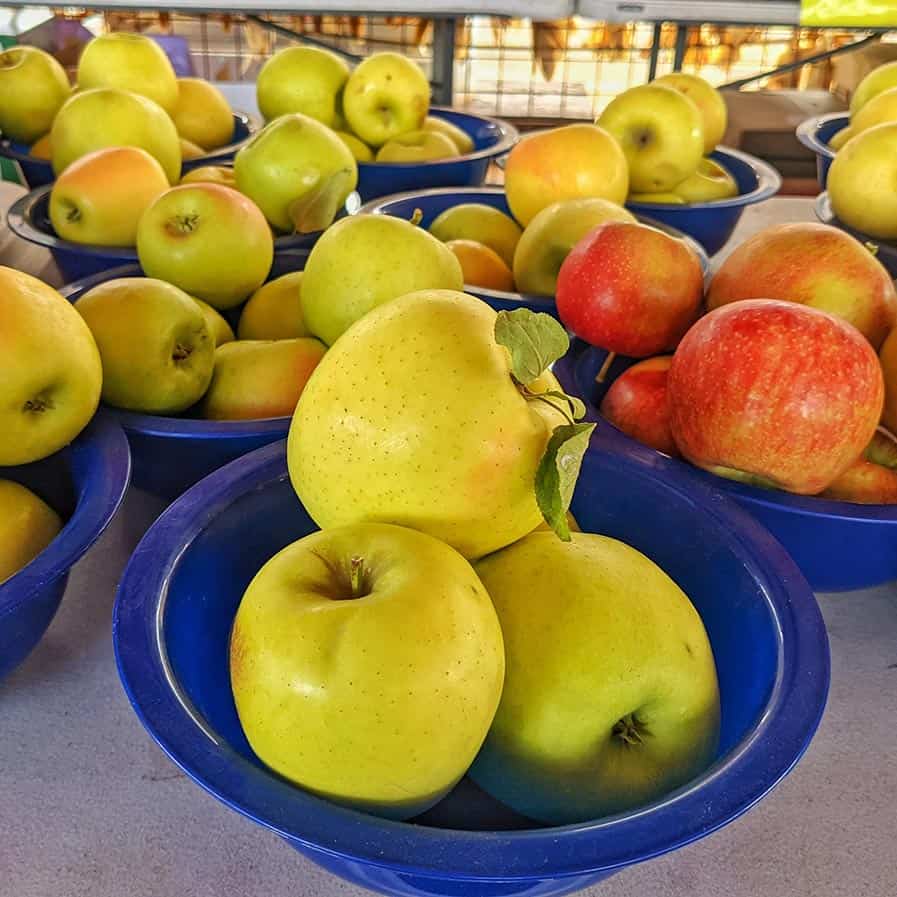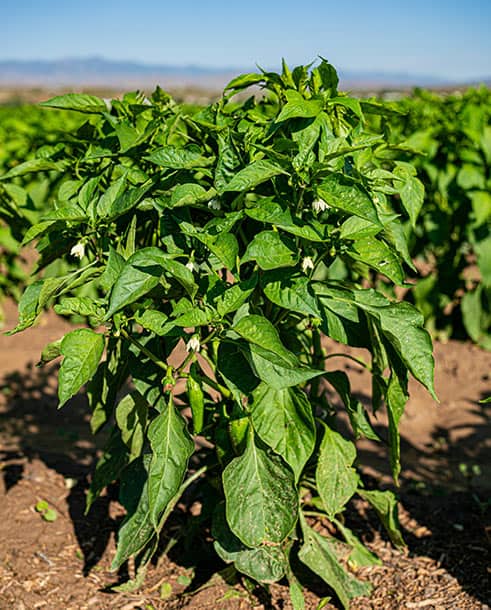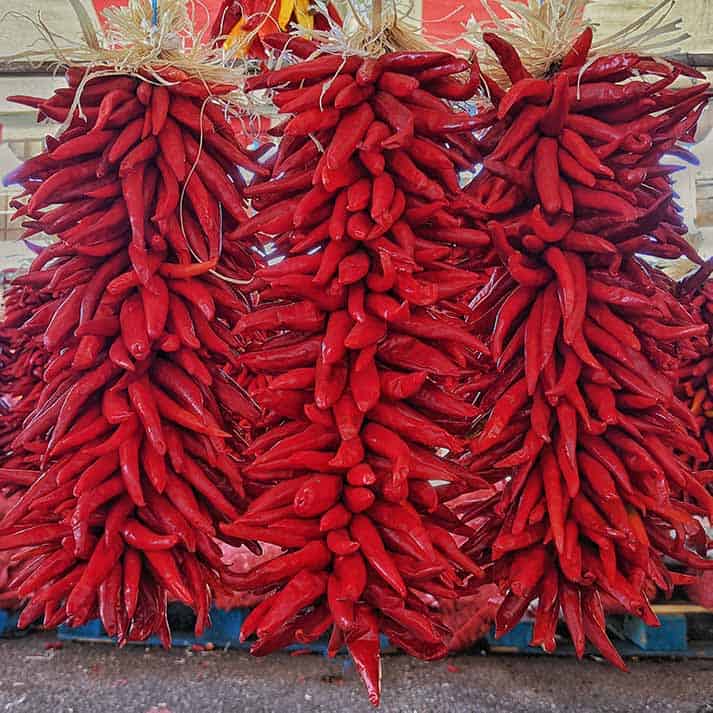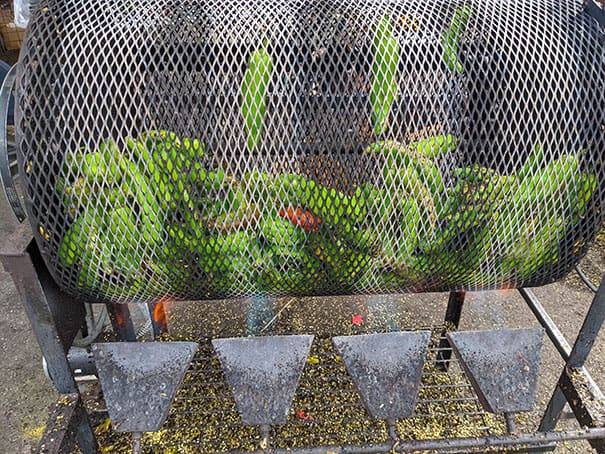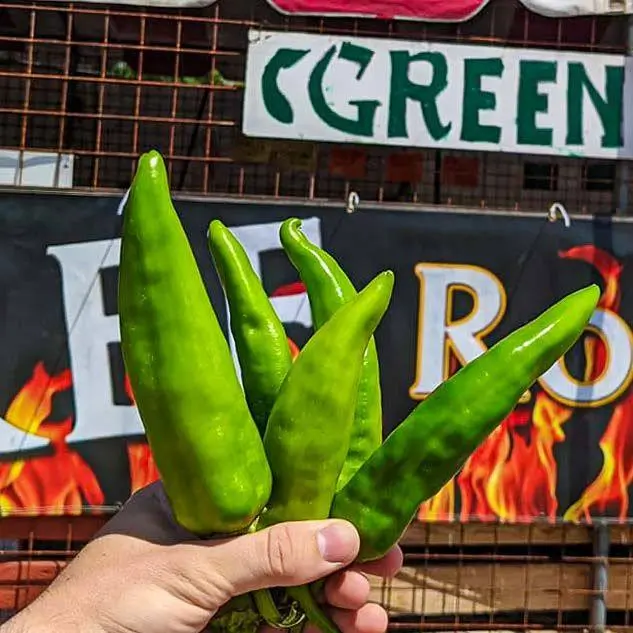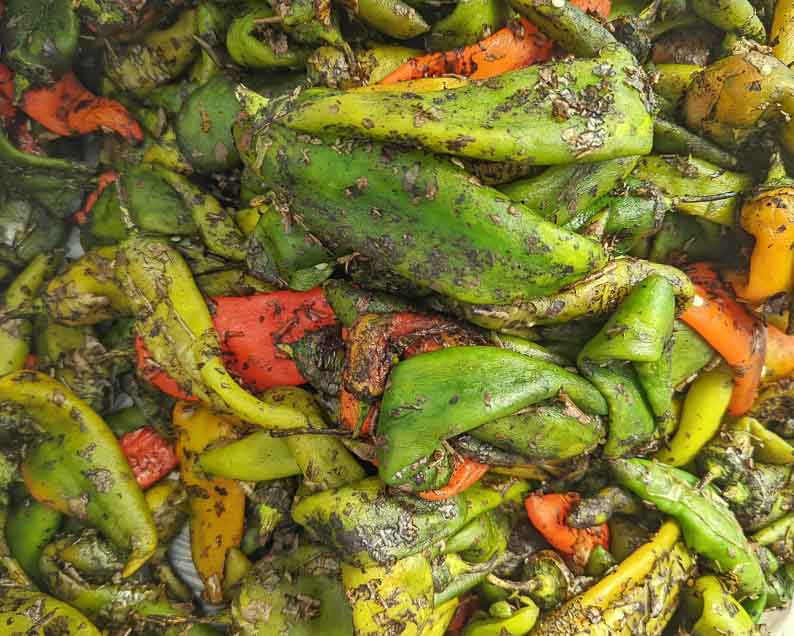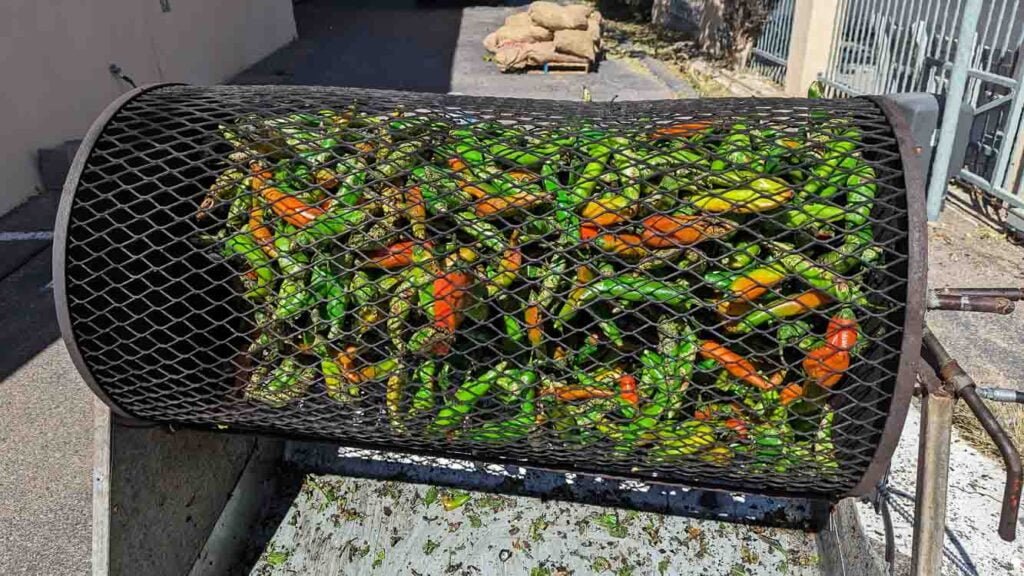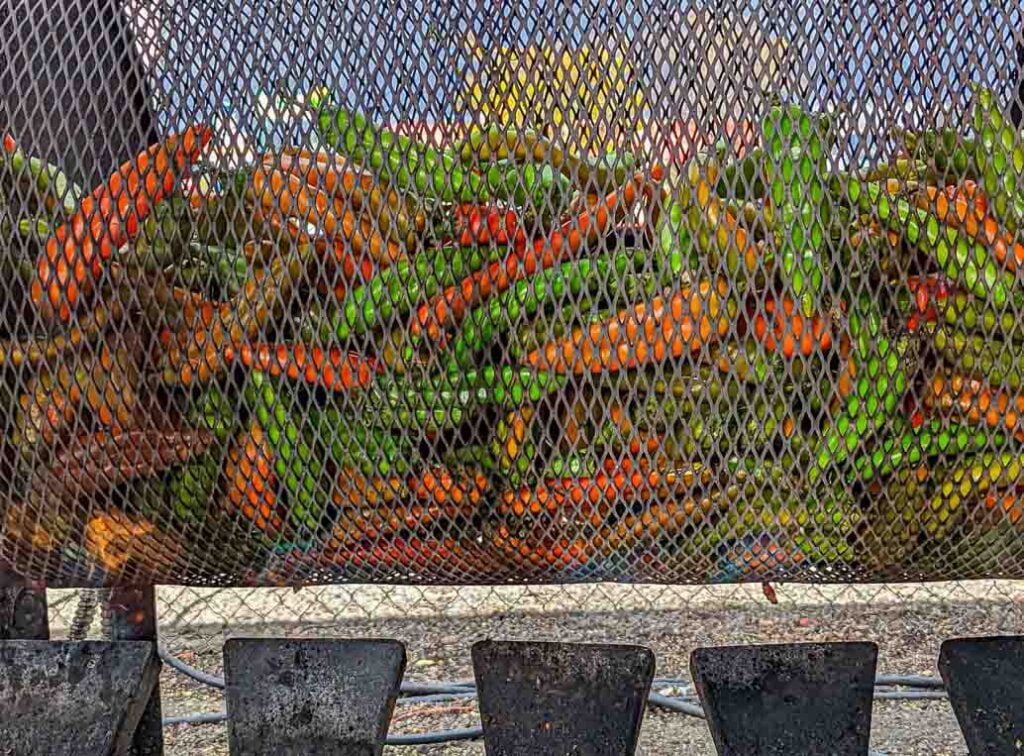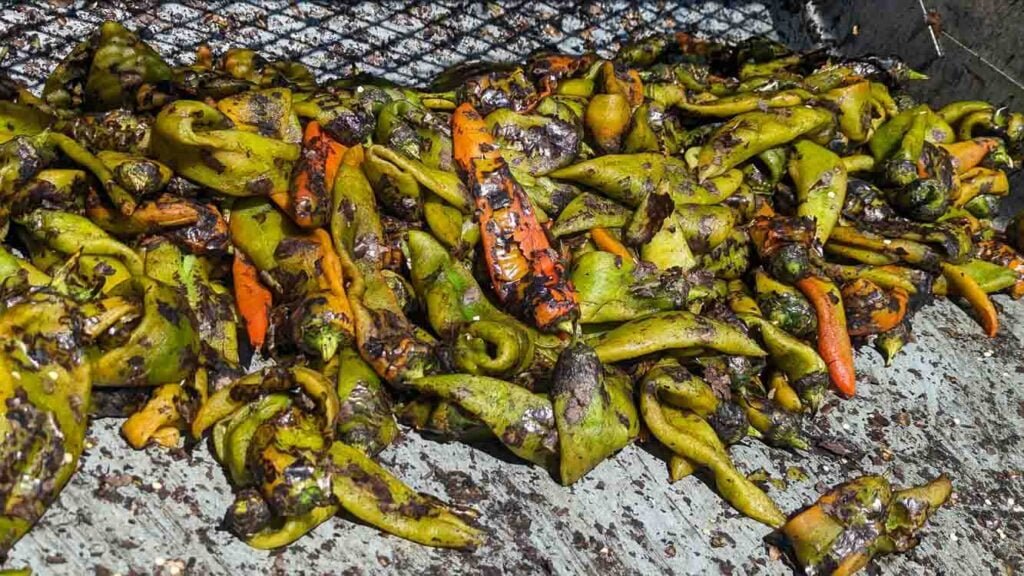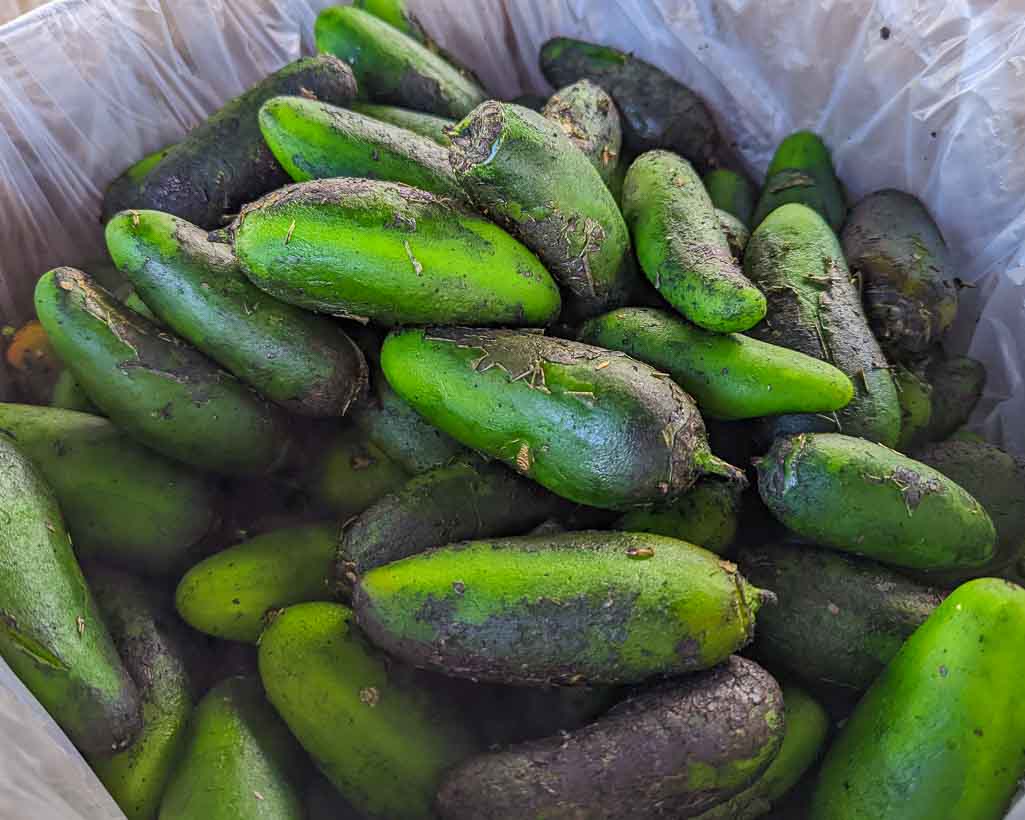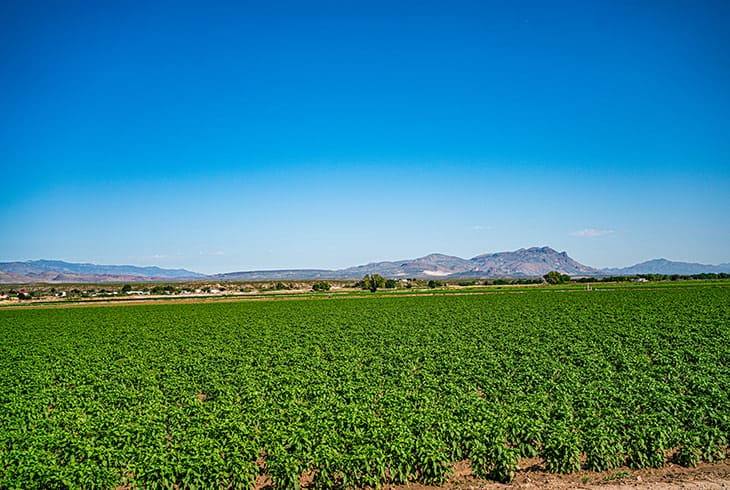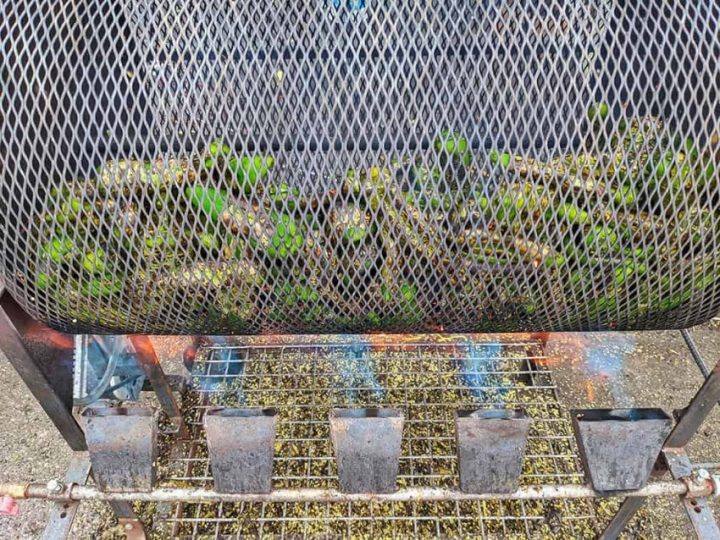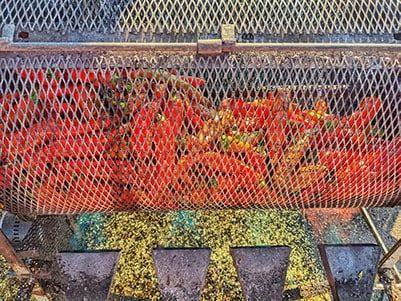Your cart is currently empty!
Month: September 2021
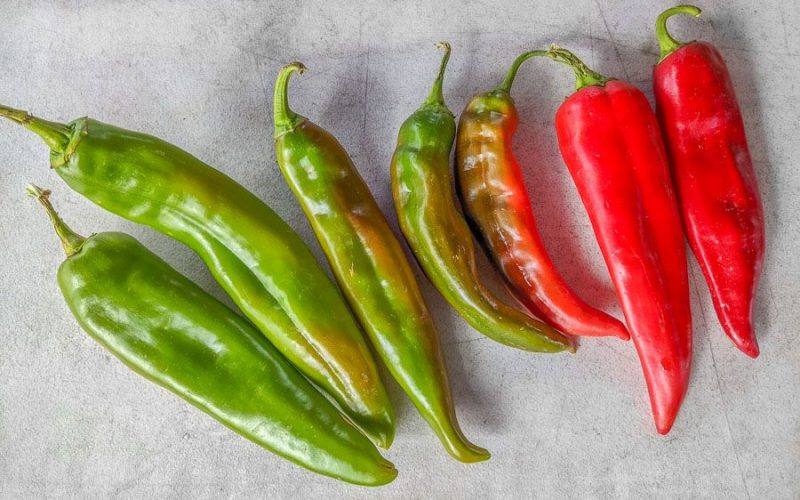
The Many Varieties of Chile
Many types of New Mexico chile
Although we sell green chile by temperature, Mild, Medium, Hot, Extra Hot, XXX-hot, etc, the differences between New Mexico chile varieties run deeper than that.
Chile has been a big thing in New Mexico for a long time, and as a result, many different varieties exist. Many are bred for their size and meatiness, such as Big Jim. Some are bred to bring the heat, like Lumbre. Some chile is bred to mass produce, like Arizona 88. We don’t sell that one, as it is an inferior product, but most giant grocery stores do. Everyone has something different they look for in New Mexico chile, and that is why we let people see and try the chile before they buy. It is important for us to make sure you have the best possible chile experience.
The purpose of Different chile
Every chile serves a purpose, which includes much more than simply heat level. For our hot green chile, we generally get Miss Junie. Our ristras are made with Sandia, a chile variety developed by Roy Harper in 1956. Both are a solid “hot” temperature, but the Miss Junie a is slightly spicier, more meaty variety, which means it will roast better. Sandia is less so, which leads to better drying.
There are many different things that consumers look for in chile. Sometimes they need chile that is long and straight, so they can make chile rellenos. Big Jim, a cultivar developed by Roy Nakayama in the 1970s is typically the best for this. The mild 1904 and 6-4 varieties also work, as well as the hot Miss Junie.
Sometimes, people want as hot as possible. Traditionally, Barker was the choice for spice-lords, but Lumbre has overtaken its throne in recent years. Barker remains as the primary extra hot variety at Farmers Chile Market and most other chile stores. Lumbre is our XXX-hot variety.
The original New Mexico chile pepper was Numex No. 9, developed and released by Fabian Garcia a little over 100 years ago. Although it is not as common as other famous varieties of New Mexico chile in modern times, its purpose as the forefather of Hatch chile will always be significant.
Differences in the same varieties
Red or Green?
Red chile and green chile is another factor which is important. Green chiles have many differences with red. Red fruits are more mature, with a lot more sugar. They take longer to roast, and the peel is more resilient. They also dry much better, and hold their shape well, where green typically shrivels and doesn’t look great.
Red Chile
New Mexico chile typically ripens up to become red chile. Fresh red chile is quite sweet, but most people don’t eat it when it is fresh. Instead, most red chile is sun dried. These sun dried red chile pods are then ground into red chile powder by processors in Hatch New Mexico, or sold to consumers as whole chile pods. These pods are the base of New Mexico’s mother sauce, the red chile sauce. The arrival of fresh red chile is also a big milestone in the chile season, as it means that chile ristras are available. Although ristras are often used as just a decoration, they are also edible if they are untreated, and many fantastic chile sauces are made with chile ristras!
Green Chile
The arrival of green chile marks the beginning of what people refer to as the chile season, which typically goes from the start of August to nearly the end of October. Green chile is almost exclusively roasted and peeled before eating, but green chile powder has also become more and more popular in recent years. After roasting, it is typically bagged up in freezer bags and frozen for consumption at a later date. Chile Pasado is another way to preserve roasted green chile by drying it. Green chile is much less sweet than red chile, and I would argue that its flavor is somewhat more grassy and herbal than red. Due to it needing to be roasted to peel it off, I recommend finding a good chile roaster, or reading our guide to roasting green chile!
Common New Mexico Chile Varieties
Mild Chile Types
There are many chile varieties such as R Naky which are primarily grown as paprika type chile, and not meant to be roasted. As we are a chile roaster, we will primarily focus on chile commonly used in roasting or making New Mexican food.
New Mexico 6-4
This variety was developed as a team effort at NMSU based on Numex No 6, which was released by Dr. Roy Harper back in the 1940s. In Modern times, the NuMex Heritage 6-4 variety has become more common. It’s heat level is typically around 1,500 Scoville Heat Units, SHU or less.
NuMex Joe E. Parker
Another mild variety which was released in 1990, this chile is typically around 1,000 SHU.
Medium Chile Types
Big Jim Chile
The Big Jim chile variety was developed by Dr Roy Nakayama in the 1970s at NMSU in collaboration with famed chile farmer “Big Jim Lytle”. This chile went on to be labelled by Guinness as the world’s largest chile pepper. Possessing a medium heat, this is by far the best chile variety to be used for chile rellenos! In modern times, NuMex Heritage Big Jim has become more common. Big Jim is somewhat notorious for being a bit inconsistent in heat level, with some peppers being rather mild, while others are up to 9,000 SHU. Along with something I like to call “spiceflation,” or the perceived heat level going down as people desensitize themselves with hotter and hotter chile, more and more people are regarding Big Jim as Mild. We still classify it as medium, because it has been for the past 50 years. Maybe we will change this at some point, but we also have a long history and want to respect our New Mexico traditions!
Hot Chile Types
Sandia Chile
This is the traditional “hot” New Mexico chile, and has been since it was release in the 1956 by Dr. Roy Harper. Sandia is the primary chile used to make red chile ristras in New Mexico. A more modern version of Sandia, known as Sandia Select is also a great chile for roasting, as it is bigger and thicker.
Ms Junie
This relatively new chile variety was developed by Solar Dry Chile in Hatch. Named after the late, June Louise Franzoy Lytle Rutherford, this chile is somewhere between Big Jim and Sandia in size, while also being hotter than Sandia too! Although some chile vendors will mark this as an extra hot chile, it still is lighter in heat level than a Barker variety. Miss Junie is an amazing chile for roasting as it is big, thick, and juicy! It even works great in chile rellenos too. One major downside to it, is that because it is so juicy, it doesn’t dry as well in the sun. This is why ristras are usually made with Sandia chile over Ms Junie still.
Extra Hot Chile Types
Barker Chile
Barker chile has been the typical extra hot variety in New Mexico for as long as I can remember. It is quite a bit smaller than either Sandia or Miss Junie, but is almost always a decent amount spicier than either. Barker is more difficult to roast than other varieties of chile, as it is more prone to burning. It is not as juicy as many types of chile, so a roaster needs to pay attention when roasting this variety.
Hotter than Extra-Hot Types
Lumbre Chile
As of now, the most consistently hot New Mexico chile variety I know of is the Lumbre chile. It was developed in recent years by Jimmy Lyttle, son of “Big Jim” Lyttle. This veins of this chile are yellow, orange, and red, which should frighten you if you are afraid of spice. When we roast this chile, even the air around the roaster becomes spicy. We call this chile XXX-hot, because it is dangerous how spicy it is. Although it won’t be too hot for someone who eats ghost peppers like candy, when you eat a dish with a green chile sauce made of lumbre chile, you will feel the heat! We also try to carry this in dried red chile pods, but it often sells out within a day or two. If you see lumbre red chile pods, buy them right away!
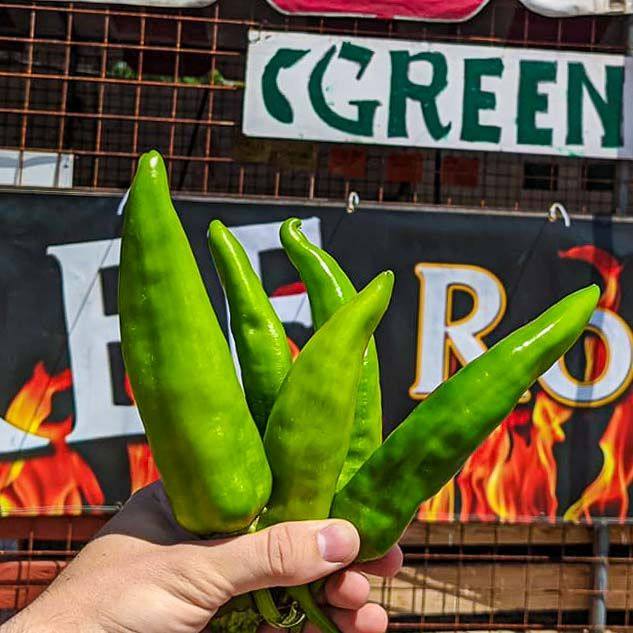
Super spicy New Mexican Lumbre chiles Other types of chili Peppers
Superhot Chili Peppers
Superhot chilies are a new trend in chili pepper cultivation. twenty five years ago, the hottest peppers you might find would be things like habanero and scotch bonnets. Although the red savina pepper was the hottest in the world, few people really knew much about it at the time. The first superhot pepper to really kick off the modern spice craze was the bhut jolokia, or ghost pepper as it is most commonly known. Dr Paul Bosland of NMSU’s Chile Pepper Institute said this pepper “kind of opened the floodgates.”
Since then, other peppers emerged, with a new one taking the crown every year or two. Trinidad moruga scorpions were the top dog until they got overturned by the Carolina Reaper, which as just recently been overtaken by Pepper X. The amount of superhot chile varieties available now is immense, with tons of growers and researchers trying to make their own mark. One popular chile variety is the 7 pot, which has many different strains. You might have heard about a California reaper, which is a yellow version of the red Carolina reaper.
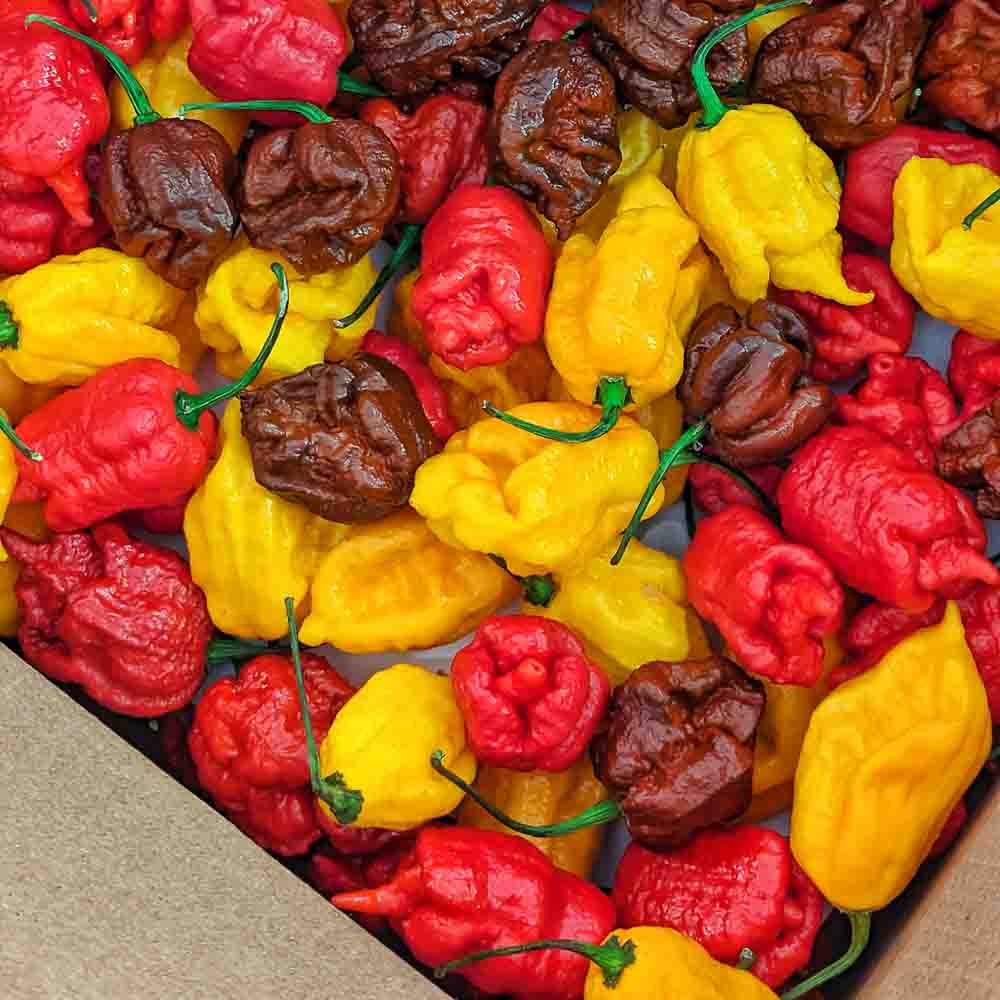
New hottest peppers
Although unconfirmed by Guinness, there are some new peppers that are rumored to be even spicier than the Carolina Reaper. If you ever hear of Dragons Breath or Pepper X, be prepared, as they are supposedly much hotter than even the Carolina Reaper. These new chile peppers are pure fire.
Sweet peppers
Along with a boom in superhots came a boom in the sweet pepper department as well. For decades, you could find a few colors of bell peppers at any old grocery store. These mild peppers give a good flavor and juiciness to any dish they are in, along with tons of health benefits. There are a lot of different sweet peppers available, such as the Corno di Toro. The Hamik pepper is one of the sweetest peppers you can find, with sweetness that makes it comparable to many fruits.
Famous peppers around the world
Many countries have their own chile traditions and cultures, just like us in New Mexico. In Japan, their most famous chile is the shishito pepper, which goes really great flame roasted and paired with beer. It is a very common bar food in Japan. In southeast Asia, the Thai or birds eye pepper reigns supreme, but stroll down any market, and you will see tons of different types of chile that you can never find in the US. If you get pho in the US, it typically has jalapenos, but in Vietnam, it typically comes with a local green chili and lime wedges. Mexico, has some of the most famous chile varieties in the US, so we have an entire post about different types of Mexican chile peppers!
India and Sri Lanka are famous for spicy food, which explains why the ghost pepper and naga chile varieties came from there. Trinidad is also quite famous for both the Trinidad Scorpion and the 7 pot varieties of chile. Cayenne pepper is another super famous pepper, and arguably the most used for spice powder which adds heat. Paprika is of course more common, but mild.
The world is a big place, and although I do consider myself a chile expert, my field is primarily related to chile in New Mexico. Because of that, I can’t list off every single pepper, but I can say that the amount of different pepper cultivars is simply astonishing. You will find different chile everywhere you go, as long as the cuisine is one that appreciates spice.
New Mexican Spice
Although there are many different types of chile peppers in the world, New Mexico is unique in a major way. We eat chile with literally everything. In a day, you might have three different meals and a snack, all containing chile. Whether it is green chile scrambled eggs for breakfast, a chile cheeseburger for lunch, some red chile beef jerky for a snack, or something else, we eat more chile than anywhere. Hatch is the Chile Capital of the World, but we love our chile everywhere in New Mexico. In fact, we love it so much, that even our neighbors can’t resist! Chile roasting season is a very important thing for us in New Mexico. It is especially important to us at Farmers Chile Market. We hope to be your destination to get your roasted chile in 2024!

Local New Mexican produce
We sell a lot more than red and green chile.
We’ve always been a big proponent of local produce, as the farmers can pick one day and deliver to us the next day. This allows the fruit more time to ripen on the plant, instead of being picked early.
Often this leads to the fruit being more fragile, as it is softer, and not protected by waxes or antifungal treatments. Local produce is generally less beautiful than produce produced in big farms in California or Mexico.
There is a tradeoff however, because fruit picked ripe is much more delicious. There is a reason we sell so many different local fruits at our chile stand.
Benefits of buying local
More than just flavor, buying locally grown produce strengthens our community and reduces our carbon footprint. There are many reasons to buy local, and we have always tried to promote that. For us, the main reason has always been providing the best possible quality produce. In our industry, things go bad in days, not weeks. If we get it fresh, we can sell it fresh. This helps ensure we have happy customers who remember us every chile season. It’s great that there are so many other benefits to buying local too. With covid and geopolitical problems, we now face supply chain issues, and shortening the supply chain makes us a stronger society, which is less prone to shortages, and more able to support itself.
Remember, you can always find us at 2010 Eubank, Albuquerque, NM 87112. We carry many different seasonal New Mexican products when they are available, including cantaloupes, watermelons, pumpkins, posole, tomatoes, onions, apples, and more. We aren’t just a chile roaster. If you want to buy local, remember Farmers Chile Market. We are a great spot to support the local community, and pick up roasted New Mexico green chile and red chile ristras along with your produce from Hatch, or another great growing area in New Mexico.

Ode to Chile Pickers
Picking chile is a pretty high paid job. In general, pickers have been making more than $15 an hour for years. That being said, I think there are few jobs more difficult that picking chile.
The plants themselves don’t grow much higher than 2 feet. They also keep producing and need to be harvested about 5 times per plant, so they can’t be cut down to simplify the process like some other plants. Bending down and picking chile is hard enough, but then also need to lift a heavy basket into the bin as well. On top of that, they do all of it in the sun. Chile plants love the sun and are too short to provide any shade.
The average high for the Hatch and Socorro valleys is in the mid 90s throughout chile season, regularly breaking 100 degrees. Talk about sweltering. Picking chile in New Mexico is some seriously hard work. It is a job that really does deserve good compensation.
We are incredibly grateful to the pickers in Hatch and San Antonio, New Mexico, where we get most of our chile from. Without them, we wouldn’t have green chile to roast, nor would we have red chile for ristras. They are certainly an integral part of New Mexican society.

Pequin Chile is more than just a decoration
Every year around mid September, New Mexico is awash in different shapes of chile ristras. If you find a ristra in the shape of a heart, wreath, cross, or something else, it’s probably made with pequin chile.
The reason why, is because it is smaller, and therefore less fragile. In general, most people just use these ristras for decoration. Like other ristras, the original intention is a way to dry chiles without letting birds eat them.
The flavor of pequin chile is somewhat fruity, with a slightly nutty aftertaste. The spice is a lot more than a Hatch chile however, so be careful when eating them. The spice level is more in line with Thai chilies or cayenne peppers.
You might be wondering a good way to use them. As they are small, cutting them individually is not very convenient. Blending some into a sauce is a great way to add some spice. You can also make a decent DIY tabasco style sauce by blending them with vinegar and a little salt.
There are a lot of uses for this kind of hot sauce, and you can mix whatever you want with it.
This season, remember, chile ristras aren’t just decoration. Make something tasty with them too.

How to roast Hatch chile
If you want to know how to roast New Mexico green chile, or most chile peppers, look no further. If you have arrived here, odds are you got yourself a sack or box of chile from New Mexico during the relatively short Hatch chile season! You might be wondering to yourself, “How do I roast all this Hatch chile?” Whether you want to roast at over an open flame at home or are planning to roast professionally this year, read on to find out all about roasting New Mexico’s favorite ingredient, green chile.
Two ways to roast Hatch Chile
I wrote two primary ways to roast Hatch chile on this page, the first will be for how to roast at home, whether it is on the BBQ grill, an oven broiler, or on the stove. The second method will be targeted towards professional roasters who will be roasting using big barrel shaped Hatch chile roasters. Click down to our guide for professional roasters, but read the next section first to understand the overall process first. It works for both roasting at home and a chile roaster.
Understanding Chile Roasting
To begin with, we need to analyze what we want from the roast. In general, the purpose of roasting is mainly to peel the chile, with a smaller emphasis put on giving it a smoky flavor profile.
In order to peel a chile, it has to have a point where it peels FROM. That means you need a lot of direct heat on the chile to blister it. These blisters are fracture points of the peel, and where you can start to pull it off. From a more food science based perspective, the blisters form because of a pressure difference between the high heat of the peel and the cooler heat of the fruit inside the peel. Creating this difference causes blisters to form and then pop, which can then be peeled away from the chile. If the chile is already hot, your heat source is not hot enough, or something is lowering the heat level like water evaporating on the peel, blisters won’t properly form.
Use High Heat
So, step 1 is high heat, as hot as you can. This would be your oven’s broiler, a BBQ grill, or a blowtorch. Or you can be like me and have more than a few barrel roasters lying around. Those can blister a chile quite well, trust me!
You want to keep it on that high source of heat for about 3-4 minutes, but watch carefully. If you heat the chile for too long, it will burn, and the peel will turn to ash and stick back on the fruit. Blackening is good, and if a little more than half of a side of chile blackens, it is still ok. Too much more than that and you will risk burning the inside of the chile too.
Do I Need to Roast Hatch Chile?
Yes, you do. Although New Mexico chile is technically edible raw, I can’t think of a single New Mexican who eats it that way. The only time we have raw green chile is when we are sampling the heat level before committing to getting a full 40 lb sack roasted. The peel of our chile is very thick and plasticky, and the chile is quite thick and hard too. Roasting chile burns off the peel and tenderizes the fruit of the chile as well! When you factor that in with the delicious smoky flavor that roasting provides, the answer to this question is a no brainer! Roast your chile, or get someone to roast it for you. It’s worth it, trust me!

These aren’t too hard to roast, read on to learn how! How to Roast Green Chile at Home
Preparing to Roast Green Chile
Prepare your roasting area, or your mise en place as chefs might call it. Odds are you have a lot of Hatch chile to roast, and will need to do it in batches. Get your chile all ready on one side of your roasting area, whether it is your oven, barbecue grill, blowtorching area, or a grate on top of a gas stove. On the other side, prepare an area to leave the chile to steam after it is roasted. Steaming is an important part of chile roasting that not only makes the chile easier to peel, but also makes the chile’s spice level more even.
Starting the roast
Give each chile a few pokes on different sides with a sturdy toothpick, a needle, or a fork. Because roasting at home typically doesn’t have rotation like a barrel roaster, it can lead to a pressure imbalance causing some chilies to pop. Poking a few holes allows gas to escape the chile, so they don’t pop. Don’t poke holes all over the chile, because it also allows water to escape the chile and run over the peel. This water will lower the temperature when it evaporates, and prevent proper blistering if there are too many holes. A few pokes in random areas should be enough.
Blister over high heat
After giving the chile a poke, it’s time to roast! Be sure to heat up your roasting element before you add the chile, so you burn the peel before too much water starts flowing out of the chile. Put your Hatch chile in the oven under high broil, on the barbecue over an open flame, or in a safe area to blowtorch. It all will roast well if your heat is hot enough. Let it sit on each side for about 3 minutes, then flip a single chile pepper to check for blackening. If it is about 50%, then it’s time to start flipping. If it is less than that, you might want to wait a little longer before flipping. Don’t be afraid of the peel turning black, the point of roasting chile is to burn that so it comes off!
Roast all Sides of the Chile
Flip it over, and do the same to the other side. Some chiles are more bell shaped and have more than 2 sides, just turn them over again. Once you blacken all the sides, put them in a bag or a bowl covered with a towel you don’t mind staining. Let the chile steam for a little bit to help the peel loosen and also let the heat of the chile mix together and standardize a little bit. You can also give it a dump in cold water to help loosen the peel also. The rapid change in temperature can help separate the peel even more, but this isn’t really traditional and may dilute the flavor a bit.

The fruit of your labor! Peel Chile when you want
Every New Mexican has a different opinion on when to peel chile. Many people like to peel it before they freeze it, so they have less work when they are preparing a green chile sauce or a topping for a green chile cheeseburger. Other people prefer to peel chile after they freeze it, saying that it is easier to peel. Personally, I like to freeze with the peel on. The peel can help prevent the effects of freezer burn, and also leads to a more smoky flavor in your green chile! Be sure to read our guide to peeling chile!
Bag up your chile
Get a box of freezer bags, and bag up your chile. I recommend going for about 1 lb per quart bag, so it is easy to pull apart. When the bags are full to your liking, squeeze out as much air as possible and close the bags. Getting them airtight will help prevent freezer burn and keep your roasted Hatch green chiles looking and tasting great! Spread your chile bags out so they cool off faster, then put them in your freezer when they aren’t hot anymore. Don’t let them sit out too long for food safety reasons.
How to Roast Chile With a Barrel Roaster

A sack of chile that went in about 1-2 minutes before The vast majority of chile pepper roasters that roast for customers are made in a barrel shape. The barrel roasters are great, because they not only roast the chile, but the spinning peels them as well. In case you are going to be roasting chile at a grocery store, popup, or somewhere else this year, this guide can help you understand how to roast chile, make your customers happy, and make more in tips too!
Set up your Roasting area
Roast chile safely
Roasting green chile is dangerous, so it is your responsibility to ensure it is as safe as possible. Be sure to prevent trip hazards to the best of your ability. Check your gas hoses every day by using a spray bottle and soapy water. Check every connection, and the hose itself near the roaster and main propane tank. Be sure that your PSI regulator is set to the allowed level that your local propane authority allows. I keep 5 fire extinguishers at my chile stand, including 3 in the roasting area, one near the register, and one near the back. It is very important to have fire extinguishers nearby to quickly put out a fire. In case there is a problem at my chile stand, I know that I can have three different people each with fire extinguishers in mere seconds. Your chile roasting area should be set up in the same way. Fires happen, especially on windy days. In case it happens, don’t panic. Turn off the gas and calmly put out the fire.
Organize Your Roasting Area
Organize your different flavors of chile in a way that makes it hard to make mistakes. Keep the mild, medium, hot, and extra hot in the same place every time. Additionally, don’t put the mild next to the extra hot, so if you or a coworker does make a mistake, it is a smaller one. No one likes getting the wrong flavor of chile, but getting extra hot when you wanted mild chile is far worse than getting extra hot when you wanted hot. Everyone makes mistakes, but limiting the potential for mistakes will allow you to please more customers.
Starting the roast like a Pro
The first step is to put the chile in the roaster. Depending on the sack you use, you might need a knife or clippers to cut it open, as most farmers tie them with twine or use zipties to close the sacks. Put the chile in the roaster, pick out any burlap, tags, or rotting chile and close it up. Be sure to use proper protection during all steps, as it is easy to burn yourself on the hot metal of a chile roaster! Don’t forget to wear your gloves! We use both 18 and 24 inch welding gloves at Farmers Chile Market.
Turn Up the Heat!
The next step is to turn on the heat at full blast, then turn on the motor to spin the barrel around right after. I like to do this, as the high flame will cause a lot of small blisters to form on the chile for a second or two before the roaster spins. These blisters will certainly lead to easy to peel chile. I cannot overstate the importance of starting the chile roast at the highest heat you can. This is the single most important thing to do to ensure you have a good roast, as the pressure difference caused by heating the peel faster than the inside of the chile is how it separates.
Watch the Chile, Every Sack is Unique!
This step takes about 3 or 4 minutes, but every sack of chile is different. Smaller chile is more delicate and cooks faster, bigger chile cooks slower. Red chiles also cook slower, and green will often begin to burn before red starts peeling. The general rule is, the bigger and redder the chile, the longer this step takes. There are MANY variables though, so don’t take general rules as facts. If it is hot outside, chile roasts faster than if it is cold. It takes about 2-3 minutes longer for us to roast on average in October than if we roast in August. If it is windy, chile takes longer to roast too. Pay attention to every single sack of chile you roast, as a timer won’t tell you the whole story.

Chile can vary a lot in terms of ripeness and size, so treat every sack of chile as a unique roast Turn the heat down and let it spin
What I look for is most chiles should be fairly blackened, with the tips starting to peel before I turn the heat down. If you turn down the heat too early, the chile will cook, but the outside won’t be blistered enough to peel well. If you can see the tips of most chiles peeling, then it means you can turn down the roaster.
After turning the flames down to a low medium, let the roaster spin another 3 or 4 minutes. The friction along with the pressure from the fire will help peel the chiles without burning them.
If the peel is stubborn and doesn’t seem to want to come off, turn the heat back on high for about 20 seconds, then go back down. It will peel, some sacks just take longer than others.
Every sack of chile is unique and will roast differently. When I train chile roasters, I always explain this. The key factors are blisters, which lead to points where the peel separates from the fruit. This mainly happens early on in the roast process, as the juice will be flowing later on, lowering the temperature as it evaporates. Blisters need very hot temperatures in order to form, so start with full burn right away then lower the flame later.
If you start a roast well, it should be a good roast, just don’t let it get too black, and don’t spin it too long.
Dropping and bagging the chile
Make sure to clean off the chute of your roaster before you drop it from the roaster and bag it up, so the customer doesn’t get a bag full of excess chile peels. Put the chile into 2 bags, and pull it up in a way that squeezes most of the air out of the bag. Give it a spin, and tie it up.

If your chile looks like this at the end, you did a great job! Mark the Bags
In case your customer has gotten multiple heat levels, make sure to mark the bags properly. No one wants to get home and play a guessing game about what chile heat they got. Additionally, many people get multiple sacks at a time for different friends and family, and give them the whole bag on their way home. If the heat levels aren’t properly marked, it results in a less than optimal customer experience.
Go the Extra Mile
This is a personal request, please do everything you can to let people enjoy their New Mexico chile experience. If you aren’t slammed and can safely leave the roasting area, offering help to carry the chile out to a customer’s car also goes a long way! Chile roasters often get pretty decent tips, and going the extra mile for each customer can really help put more money in your pocket!
Visit us in Albuquerque
Although I may be biased, I think that visiting a chile roaster is a great travel idea. Whether you are trying to learn chile to roast chile in your kitchen because you love New Mexican cuisine, or you are trying to start a chile roasting operation in your hometown like me, there are plenty of things to see at a chile roaster. Although you will probably read this in the middle of chile season and might not have time this year, consider visiting New Mexico in the Fall sometime! It’s truly a great time to see and experience the flavor, culture, and events of the American Southwest!
If you are in Albuquerque during the chile season, feel free to ask how we roast. As long as it isn’t too busy, we would be glad to explain more. We are located at 2010 Eubank Blvd NE 87112 in Albuquerque. While you are there, I recommend checking out our large chile ristra selection too.

This method words great for roasting other types of chili peppers too! 
Will travel for New Mexico chile
Something nice about visiting chile farms, is that they tend to be in valleys with beautiful scenery all around. This is a picture of one of the fields at Snake Ranch in San Antonio, New Mexico, where we get most of our late season green chile from, as well as tomatoes and cantaloupe.
Every season, I travel around to different farms to see what people are growing, how things are growing, and to find out what is new. It is an important part of improving the variety of what we sell. It also gives me a great excuse to get out my camera and go on adventures. Honestly, it is probably one of my favorite things about running a chile stand.
There’s a lot of beauty in New Mexico, and chile farms are a great example of it. I’ll post pictures of Hatch farms in the future as well. Most major chile farms in New Mexico are not terribly far from I-25, as it runs nearby the Rio Grande for long stretches. This river is the source of water for chile farmers and the lifeblood of our chile growing industry in New Mexico.
Be sure to check out our article About New Mexico Chile to learn more about our state’s favorite food and why it is worth traveling for.

How to roast Hatch green chile
This page is now obsolete, and has been combined with the post How to Roast Hatch Chile to cover both roasting at home and also roasting as a professional! Please view that guide as it is much more detailed than this one!
To begin with, we need to analyze what we want from the roast. In general, the purpose of roasting is mainly to peel the chile, with a smaller emphasis put on giving it a smoky flavor profile.
In order to peel a chile, it has to have a point where it peels FROM. That means you need a lot of direct heat on the chile to blister it. These blisters are fracture points of the peel, and where you can start to pull it off.
So, step 1 is high heat, as hot as you can. This would be your oven’s broiler, a bbq grill, or a blowtorch. Or you can be like me and have a few barrel roasters lying around.
You want to keep it on that high source of heat for about 3-4 minutes, but watch carefully. If you heat the chile for too long, it will burn, and the peel will stick back onto the fruit. Blackening is good, and if up to half of a side of chile blackens, it is still ok. More than that and you will risk burning.
Flip it over, and do the same to the other side. Some chiles have more than 2 sides, just turn it over again. Once you blacken all the sides, you can peel it under a running tap. You can also give it a dump in cold water to help loosen the peel also. The rapid change in temperature can help separate the peel even more.
I hope you enjoy roasting your New Mexico green chile. If you want to skip the work of roasting, we roast chile every day in Albuquerque during chile season. You can find us at 2010 Eubank Blvd NE, Albuquerque, New Mexico 87112. Part 2 will be a guide to roasting with a barrel roaster.
In case you are just looking to buy roasted chile, we will begin roasting on Friday August 2nd, 2024 for our 47th chile roasting season!

Red chile is more than pods
When most people think of New Mexican red chile, they often think of a savory spicy sauce. They think of tamales, of enchiladas, of carne adovada. One thing about all of those is that they are generally not sweet.
Fresh red chile is incredibly sweet, much more than green. Roasting then scraping the peels off gives a very different flavor profile than what the dried red from ristras gives. When the chiles dry naturally, they ferment, and the sugar turns into alcohol, which then evaporates away. Speaking of alcohol, I’m working on a roasted red chile mead. Stay tuned for updates on that.
If you are looking to add more sweetness to a recipe, I highly recommend using some roasted red. It is harder to peel than green chile, but the earthy sweetness plays a very nice bass to the fiery trumpet of the spice.
Fresh Hatch red chile is usually available in early September, with regions such as San Antonio or Lemitar following by about a week and a half. You can find it until the fields get their first frost, which tends to be somewhere around mid to late October.
We love roasting the red, even though most places don’t roast it. It is definitely harder to roast, as it takes longer and doesn’t peel as easily, but the end result is definitely worth it. One of my favorite times of the year is when fresh red comes in. It brings ristras too, while still being early enough for plenty of green chile to still be available. I think it is the best time of year in New Mexico.
I have a great butter chicken recipe I make with roasted red that I will share soon, stay tuned for that too.
Be sure to keep us in mind this 2024 Hatch chile season! We are glad to be your favorite spot again this year for chile roasting in Albuquerque, whether you want roasted red or green!
